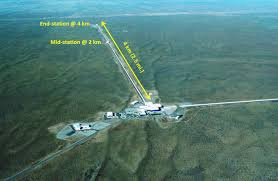The Laser Interferometer Gravitational-Wave Observatory (LIGO), housing two enormous detectors located in Hanford, Washington, and Livingston, Louisiana, is rebooting with enhanced sensitivity, thanks to a high-budget upgrade. This upgrade will help the facility detect signals from colliding black holes more frequently — approximately every two or three days, a significant increase from its previous rate of once per week in the 2019-20 period.
The Virgo detector, situated near Pisa in Italy, was set to join this initiative, having undergone its own €8.4-million (US$9-million) upgrade. However, due to technical difficulties, its team had to prolong the shutdown for additional maintenance work. “We expect to be back in operation by late summer or early fall,” stated Virgo spokesperson Gianluca Gemme, a physicist at Italy’s National Institute for Nuclear Physics in Genoa.
In other news, KAGRA, another gravitational-wave detector nestled beneath Mount Ikenoyama, Japan, is set to restart on May 24th. Despite featuring more advanced technology — as it was launched only in 2020 — it’s undergoing fine adjustments, and its sensitivity remains inferior to that of LIGO in 2015. Principal investigator and Nobel Prize laureate Takaaki Kajita, a physicist at the University of Tokyo, stated that KAGRA would accompany LIGO’s run for a month before going offline again for another commissioning phase. During this period, the team will cool the interferometer’s four principal mirrors down to 20 Kelvin — a unique aspect that distinguishes KAGRA from other detectors and will be a model for future observatories.
Gravitational waves, created by large accelerating masses, cyclically stretch and squeeze the fabric of space as they move. Since LIGO’s historic first detection in 2015, the majority of the nearly 90 gravitational-wave events documented have been generated by the spiralling motion of pairs of black holes merging into one. A few have been similarly produced by the merging of two neutron stars or a neutron star and a black hole.
The operational principle behind LIGO, Virgo, and KAGRA is the same: they use an interferometer. This device splits a laser beam in two, reflecting the resulting beams off two mirrors at the end of a lengthy vacuum pipe. In LIGO, the two “arms” of the interferometer are each 4 kilometers long, while at Virgo and KAGRA, they’re 3 kilometers. The two beams return and overlap at a sensor in the center. When space-time remains undisturbed, the beams’ oscillations nullify each other. However, when gravitational waves pass by, they alter the arms’ lengths relative to each other, disrupting the perfect overlap of waves, which is then detected as a signal by the sensor.
The challenge lies in the fact that typical gravitational-wave events alter the arms’ length by a mere fraction of a proton’s width. Detecting such minuscule changes necessitates intricate isolation from environmental and laser-induced noise.
To address this, LIGO and Virgo employed a method called “light squeezing” during their 2019-20 upgrades, which mitigates noise stemming from light particles’ inherent randomness. “It’s analogous to emptying a bucket of BBs [lead pellets]: it creates a loud hiss, but the impacts are random,” physicist Lee McCuller described. An auxiliary laser beam is introduced into the interferometer to reduce this effect, making the photons arrive more regularly and with less noise.
However, the quantum laws dictate that reducing uncertainty in photon arrival time amplifies random fluctuations in the laser waves’ intensity. This, in turn, exerts pressure on the interferometer mirrors, inducing them to tremble, which
